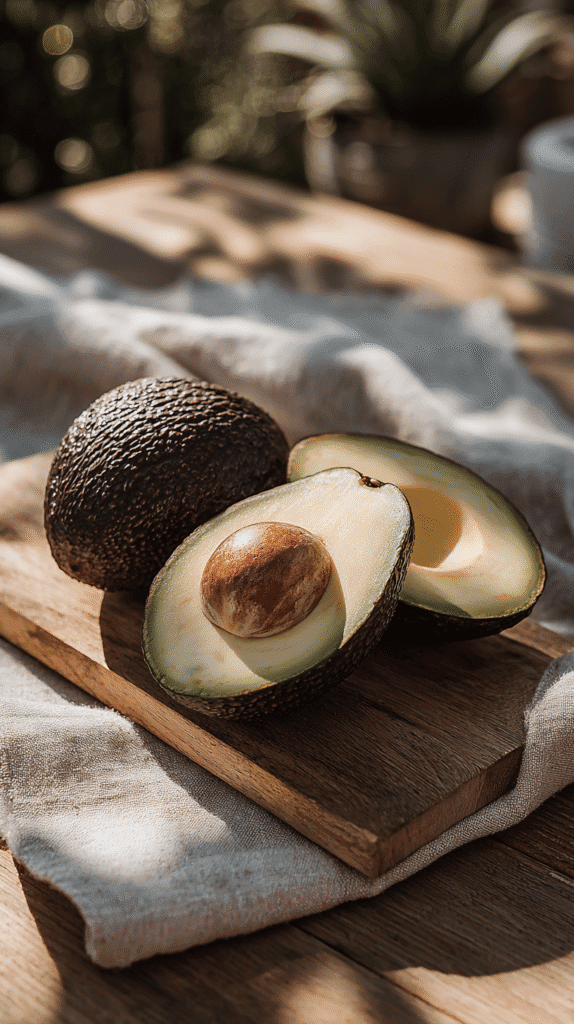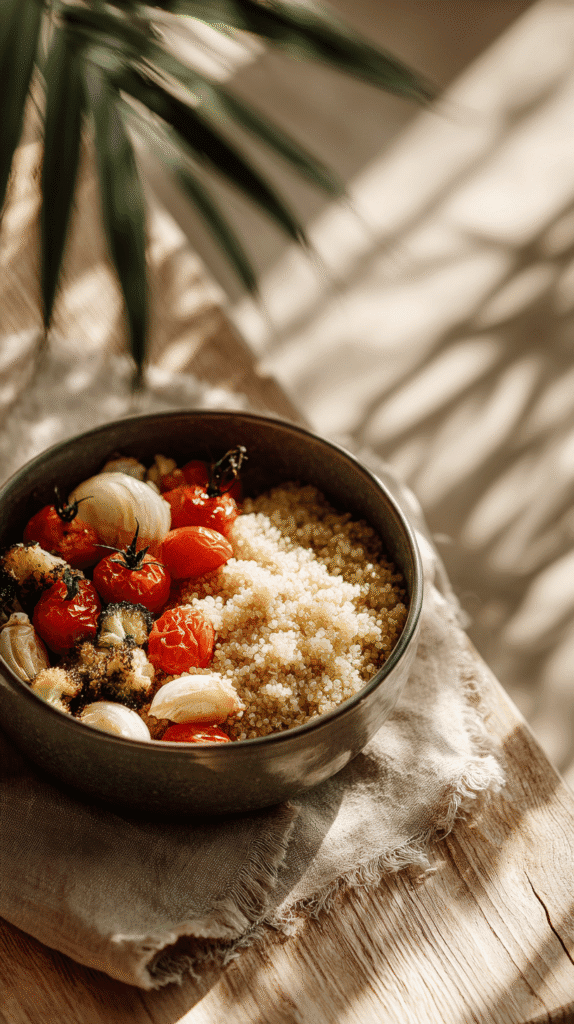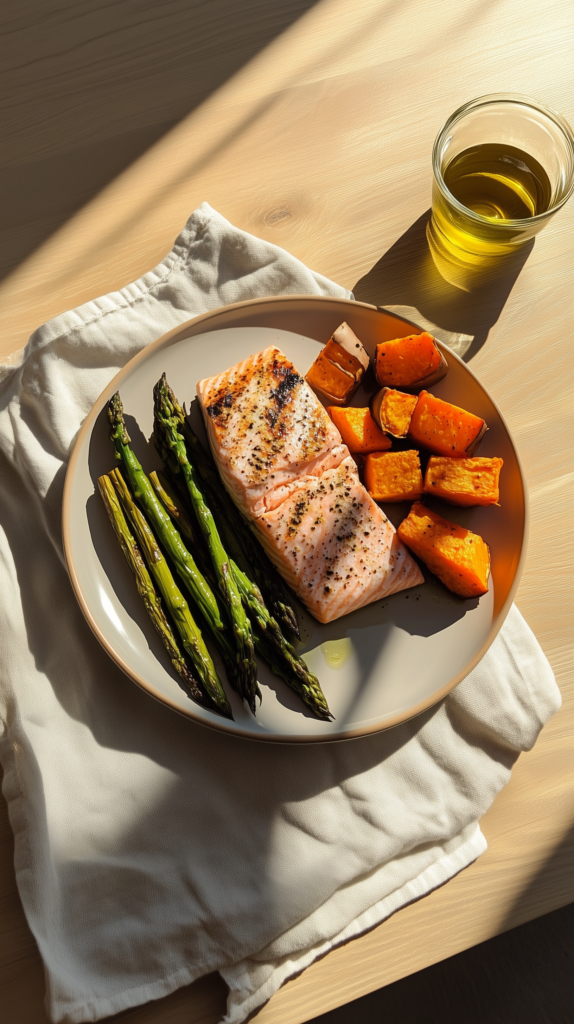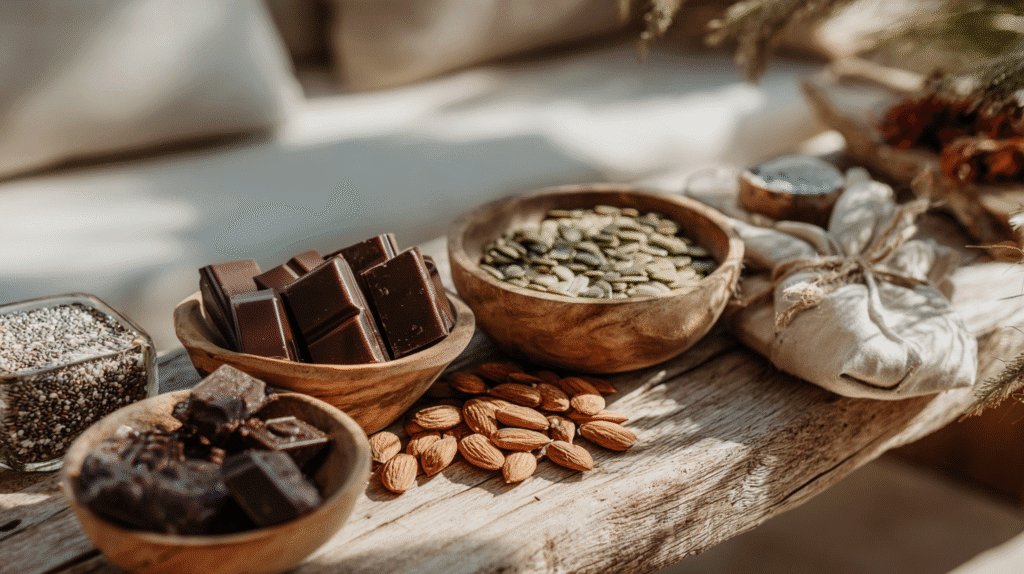This post may contain affiliate links, including those from Amazon Associates. If you make a purchase through these links, I may earn a commission at no additional cost to you. Learn more about our affiliate policy.
I’ve come to see sleep as a form of nourishment, just as important as the food we eat.
Yet so many of us struggle with restless nights, racing thoughts, or waking up too often. While there are many factors that influence sleep, one nutrient I return to again and again is magnesium.
This quiet mineral plays a powerful role in calming the nervous system, relaxing muscles, and regulating the rhythms that guide us into rest.
The beautiful part is that magnesium isn’t hard to find. It’s abundant in everyday foods that can be woven gently into your meals and snacks. Eating in a way that supports better sleep doesn’t have to mean complicated recipes or expensive ingredients.
Often, it’s as simple as a sprinkle of seeds, a handful of greens, or a square of dark chocolate savored after dinner.
Here are ten magnesium-rich foods that are easy to add into your routine, along with ideas for how to use them.

Why magnesium matters for sleep
Magnesium helps regulate neurotransmitters like GABA and melatonin, both of which play essential roles in calming the brain and signaling the body that it’s time to rest. It also relaxes muscles and soothes the nervous system, creating the conditions for deeper and more restorative sleep.
Research has shown that low magnesium levels are linked to insomnia, frequent waking, and restless sleep patterns.
The Sleep Foundation notes that maintaining healthy magnesium intake can help with both falling asleep and staying asleep by encouraging physical and mental relaxation.
The daily recommended amount for adults is around 310–420 mg depending on age and sex.
Meeting those needs through food is generally safe and beneficial, while high doses of supplements should be approached carefully and ideally under a health professional’s guidance.
1. Pumpkin seeds
Pumpkin seeds are one of the richest food sources of magnesium. Just one ounce of roasted, hulled seeds provides about 150 mg. I love sprinkling them over morning oats, blending them into smoothies, or tossing them on top of a salad.
Their nutty flavor adds texture, and their mineral content makes them a powerful yet simple sleep-support food.
2. Spinach
Leafy greens are magnesium powerhouses, and spinach is one of the easiest to find. Half a cup of cooked spinach contains about 75 mg. It wilts down quickly into soups, stir-fries, or pasta, and you can even blend a handful into your morning smoothie without changing the flavor much. Keeping greens in your weekly meals not only supports sleep but also adds a broad spectrum of other nutrients that strengthen your overall vitality.
3. Almonds
Almonds bring around 70–80 mg of magnesium per ounce, making them a wonderful snack or topping. A small handful with a piece of fruit makes an easy evening bite that won’t weigh you down. Almond butter spread on apple slices is another simple way to incorporate them. Because almonds also contain melatonin, they’re a particularly supportive bedtime snack.
4. Dark chocolate
Few things feel as indulgent yet beneficial as a square of good dark chocolate. Just one ounce of chocolate with 70–85% cocoa contains about 60 mg of magnesium.
It’s a cozy way to end dinner, though I recommend enjoying it earlier in the evening rather than right before bed since it can contain small amounts of caffeine. Choosing chocolate made with minimal ingredients keeps it closer to the clean eating spirit.
Learn to grow your own spinach in containers even if you’re a renter with this post.
5. Avocado

A medium avocado carries around 50–60 mg of magnesium, along with healthy fats and fiber.
Mashed on toast, added to a salad, or blended into a smoothie, avocados provide sustained energy during the day and calming nutrients for restful nights. Their creamy texture feels comforting, and their versatility makes them easy to enjoy often.
6. Banana
Bananas may not be the richest magnesium source, but they’re still a meaningful contributor with about 30–40 mg per medium fruit.
Combined with their potassium content, bananas are wonderful for relaxing muscles. I like pairing one with a spoonful of nut butter in the evening, it feels like dessert while gently supporting better sleep.
Another great way to enjoy them is on top of high protein overnight oats.
7. Legumes
Beans, lentils, and chickpeas all carry steady amounts of magnesium, anywhere from 40 to over 100 mg per cooked cup depending on the type. A simple lentil soup, black bean chili, or chickpea salad can easily provide a large portion of your daily needs.
Legumes are also a budget-friendly way to eat clean, offering protein and fiber alongside their mineral content.
8. Whole grains

Quinoa, oats, and brown rice are steady, grounding staples that supply 50–60 mg of magnesium per half cup cooked.
I think of them as foundations for calming meals: oats with pumpkin seeds for breakfast, quinoa tossed with roasted vegetables for lunch, or brown rice served alongside beans for dinner. Whole grains also have a grounding quality that helps the body feel settled before rest.
Learn more about having grains ready to go with easy clean eating meal planning.
9. Seeds like chia and flax
Chia and flax seeds are small but mighty, providing about 90–110 mg of magnesium per ounce.
They’re easy to stir into smoothies, overnight oats, or yogurt. I also like making chia pudding with almond milk and a touch of cinnamon for an evening treat. Seeds are proof that powerful nutrients often come in the smallest packages.
10. Fatty fish

Salmon, mackerel, and halibut all contain magnesium in addition to omega-3 fatty acids, which support brain health and reduce inflammation.
A three-ounce serving of salmon provides around 30–40 mg. Having fish for dinner a couple of times a week is a nourishing way to round out your magnesium intake while offering the added benefit of healthy fats.
How to weave these foods into your days
You don’t need to overhaul your diet to enjoy the benefits of magnesium-rich foods. Think of them as small, nourishing swaps:
- Top morning oats with pumpkin seeds and banana slices
- Add spinach to soups, stir-fries, or smoothies
- Snack on a handful of almonds in the afternoon
- End dinner with a square of dark chocolate
- Build grain bowls with quinoa, roasted vegetables, and chickpeas
- Prepare a chia pudding for an easy dessert or breakfast
These small adjustments add up, ensuring your body has the nutrients it needs to rest more easily at night.
Timing and pairing with other sleep practices
Magnesium foods can be eaten any time of day, but including them in the evening may help reinforce your body’s natural wind-down process. A light snack of banana with almond butter, or a cup of warm oats sprinkled with chia seeds, provides both comfort and mineral support before bed.
Pairing magnesium-rich foods with calming evening habits like dim lights, turning off screens, or a few minutes of journaling, creates a holistic routine that signals your body it’s time to rest.
For more ideas for natural remedies that help you sleep deeper, see this post.
Connecting with nature through food
One of the simplest ways to connect with nature is by choosing whole, unprocessed foods that come from the earth with minimal interference.
Cooking with beans, seeds, greens, and grains is not only good for your health but also a form of grounding practice. You can even grow some magnesium-rich foods, like spinach or herbs, on a windowsill to deepen the sense of connection.
These small acts remind us that nourishment doesn’t just happen in the kitchen—it begins with the earth itself.
Closing reflections
Better sleep often begins in small choices made during the day. By including more magnesium-rich foods in your meals, you’re not just supporting restful nights—you’re also nurturing your body in ways that ripple into every area of health.
You don’t need to track every milligram or cook elaborate recipes. Start with one or two foods that feel approachable: perhaps sprinkle pumpkin seeds on your salad, sauté spinach with dinner, or savor dark chocolate in the evening.
Over time, these small practices add up to steady magnesium intake and calmer, more restorative nights.
When you wake feeling rested, you’ll notice the difference in your energy, mood, and clarity. Sleep becomes less of a struggle and more of a daily rhythm, just as it was always meant to be.



